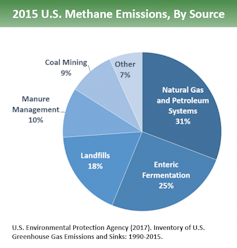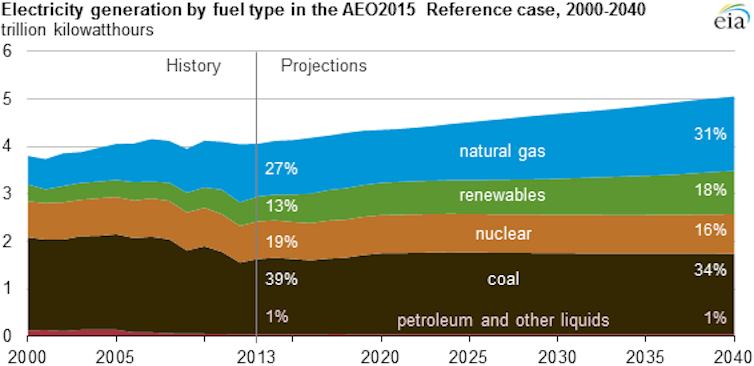How to reduce methane emissions from the oil and gas industry across North America
- Written by Kate Konschnik, Director, Climate & Energy Program, Nicholas Institute for Environmental Policy Solutions, Duke University
U.S. natural gas production has boomed in the past decade, driving gas prices sharply downward. Natural gas has become a competitive choice for electricity generation, edging out coal[1]. Because gas contains less carbon than coal[2], greenhouse gas emissions from power plants have dropped, and the U.S. grid has become cleaner, more efficient and more flexible. More natural gas is also entering the power sectors in Mexico[3] and Canada[4].
But the low-carbon profile of natural gas doesn’t tell the whole story. Methane, its primary component, is a powerful greenhouse gas. It leaks to the atmosphere from wells and pipelines, contributing to climate change and reducing the climate benefit of using natural gas.
In 2016 U.S., Canadian and Mexican leaders pledged[5] to reduce methane emissions from the oil and natural gas sector 40 to 45 percent below 2012 levels by 2025. Today, however, Canada[6] is just beginning to contemplate more comprehensive regulatory limits on methane. Mexico has made only nonbinding pledges so far, and the Trump administration is rolling back federal methane regulation[7].
 According to the Environmental Protection Agency, natural gas and petroleum systems are the largest source of methane emissions in the United States.
USEPA
According to the Environmental Protection Agency, natural gas and petroleum systems are the largest source of methane emissions in the United States.
USEPA
Scientists are still working to quantify methane emissions from oil and gas production, and to improve tools for detecting and reducing methane leaks. But even though much of the science is still uncertain, and the Trump administration is retreating from regulating methane leaks, we believe it is still possible and necessary to make progress on reducing methane emissions.
Many actors – including state and provincial governments, industry, and nongovernmental organizations – are working to advance methane measurement and mitigation efforts. To be effective, they need to work in concert. In a newly published synthesis article[8], we propose a North American Methane Reduction Framework to coordinate regulations, voluntary industry actions and scientific developments in methane estimation and mitigation. This approach can bridge the divide between science and policy, and drive new research that in turn can support better policies when governments are ready to act.
Measurement gaps and partial responses
Despite huge advances, large gaps in methane emissions inventories remain. The magnitude of leaks from oil and gas infrastructure remains disputed and insufficiently measured.
Regional studies[9] have found that up to 90 percent of emissions come from a small number of sources that leak large amounts of methane into the atmosphere. Detecting and managing these “super-emitters” is an undeveloped area of research, but offers the potential for major reductions.
There also are many discrepancies in how methane emissions are measured from place to place. States and provinces have inconsistent reporting requirements, applying different thresholds over which facilities must report emissions. And there are unexplained differences between facility-level estimates of methane coming out of leaky valves and pipes on one hand, and measurements of methane in the atmosphere near oil and gas facilities.
Meanwhile, mitigation work is proceeding slowly. Companies have detected and limited some methane leaks, recapturing what represents lost product. However, earnings from recovering fugitive methane are not always sufficient to justify voluntary action.
Environmentalists and the energy industry have common interests in finding and repairing methane leaks.This suggests a need for regulation. But the U.S. and Canadian national governments have limited authority to regulate methane leaks from oil and gas production, so states and provinces are in the driver’s seat. To date, Alberta and British Columbia have set targets, but are still developing regulations. Although natural gas is produced in 32 U.S. states, only a handful require energy companies to conduct bottom-up monitoring and repair leaks. And only California conducts atmospheric monitoring statewide to track top-down methane trends. In Mexico, the regulatory framework for oil and gas is nascent[10].
Partnering to find solutions
Our framework encourages cross-sector collaborations and scientific research that informs public policy. Scientists from industry, nongovernment organizations and universities can work together to share data and analyze emissions profiles at oil and gas sites, so long as their research is truly independent and peer-reviewed. State agencies can agree to harmonize reporting standards in order to facilitate research by scientists in all sectors. Companies can partner with enforcement agencies to deploy new sensors and measurement tools.
There are precedents for this kind of collaboration. For example, an innovative partnership[11] between industry, academics and the nonprofit Environmental Defense Fund[12] has brought together researchers to collect data and conduct methane estimation and measurements. This work is designed to improve government emissions inventories and inform mitigation policies, and is distinct from advocating for specific policy outcomes.
Similar partnerships have helped to drive solutions to other problems during national leadership voids. For example, the Extractive Industries Transparency Initiative[13] is a coalition of governments, companies, investors and civil society organizations that promotes standards for industry reporting of oil, gas, and mining revenues. While its impacts vary from country to country, the initiative has been credited with establishing transparency as an international norm[14] and promoting dialogue[15] between governments, businesses and nongovernment organizations.
 Natural gas is projected to produce a growing share of U.S. electricity in the coming decades.
Natural gas is projected to produce a growing share of U.S. electricity in the coming decades.
A continental framework
The challenge of driving action from below is to ensure that multiple actors align their efforts. Our article lays out a 10-step North American Methane Reduction process that is designed to jump-start this conversation.
It starts by assessing existing policies in the United States, Canada and Mexico. Next, the framework aims to iteratively improve policy decisions by continually advancing science and innovation around emissions, based on the number and age of oil and gas components; identifying and characterizing “super-emitters”; improving measurement and detection technologies; and finding more cost-effective mitigation strategies. This approach recognizes that policymaking cannot always wait for completion of scientific research – but it can be informed by the latest developments and can facilitate new research.
The Trump administration has slammed the brakes[16] on regulating fugitive methane emissions, but it cannot wish the problem away. Beyond climate concerns, events such as the 2010 pipeline explosion[17] that killed eight people in San Bruno, California, and the 2015-16 Aliso Canyon gas leak[18] that displaced thousands of residents from the Porter Ranch neighborhood in Los Angeles, underscore the safety risks of poorly maintained oil and gas infrastructure.
Plugging methane leaks is no simple task. Management requires measurement, and this international, cross-jurisdictional challenge requires active coordination across many groups, including industry, environmental organizations, academics, national and subnational governments, and public health and safety agencies. Our framework presents a path for integrating science and policy and addressing this uncertain challenge to move North America toward a lower carbon future.
References
- ^ edging out coal (www.eia.gov)
- ^ less carbon than coal (www.eia.gov)
- ^ Mexico (www.eia.gov)
- ^ Canada (www.neb-one.gc.ca)
- ^ pledged (obamawhitehouse.archives.gov)
- ^ Canada (www.canada.ca)
- ^ rolling back federal methane regulation (www.washingtonpost.com)
- ^ synthesis article (doi.org)
- ^ studies (dx.doi.org)
- ^ nascent (res.dallasnews.com)
- ^ innovative partnership (www.edf.org)
- ^ Environmental Defense Fund (www.edf.org)
- ^ Extractive Industries Transparency Initiative (eiti.org)
- ^ establishing transparency as an international norm (doi.org)
- ^ promoting dialogue (theconversation.com)
- ^ slammed the brakes (www.washingtonpost.com)
- ^ pipeline explosion (www.aga.org)
- ^ Aliso Canyon gas leak (theconversation.com)
Authors: Kate Konschnik, Director, Climate & Energy Program, Nicholas Institute for Environmental Policy Solutions, Duke University

